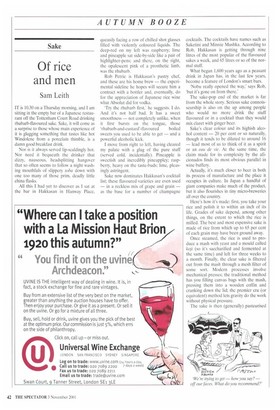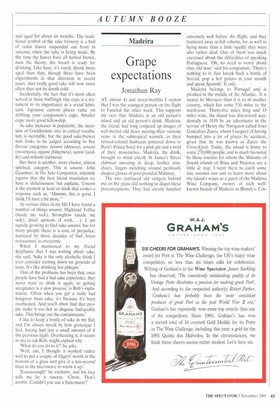Of rice and men
Sam Leith
IT is 10.30 on a Thursday morning, and I am sitting in the empty bar of a Japanese restaurant off the Tottenham Court Road drinking rhubarb-flavoured sake. Sake, it will come as a surprise to those whose main experience of it is glugging something that tastes like hot Windolene from a porcelain thimble, is a damn good breakfast drink.
Nor is it always served lip-scaldingly hot. Nor need it bequeath the drinker that dizzy, nauseous, headsplitting hangover that so often seems to follow a night washing mouthfuls of slippery soba down with one too many of those prim, deadly little china flasks.
All this I had yet to discover as I sat at the bar in Hakkasan in Hanway Place, queasily facing a row of chilled shot glasses filled with violently coloured liquids. The deep-red on my left was raspberry; lime and pineapple sat side-by-side like a pair of highlighter-pens; and there, on the right, the opalescent pink of a prosthetic limb, was the rhubarb.
Rob Petrie is Hakkasan's pastry chef, and these are his home brew — the experimental sideline he hopes will secure him a contract with a bottler and, eventually, do for the appreciation of Japanese rice wine what Absolut did for vodka.
'Try the rhubarb first,' he suggests. I do. And it's not half bad. It has a sweet smoothness — not completely unlike, when it first bursts on the tongue, those `rhubarb-and-custard'-flavoured boiled sweets you used to be able to get — and a powerful alcoholic kick.
I move from right to left, having cleared my palate with a glug of the pure stuff (served cold, incidentally). Pineapple is sweetish and incredibly pineappley; raspberry, heavy on the taste-buds; lime, pleasingly astringent.
Sake now dominates Hakkasan's cocktail list; these flavoured varieties are even used — in a reckless mix of grape and grain — as the base for a number of champagne cocktails. The cocktails have names such as Saketini and Minnie Mushka. According to Rob. Hakkasan is getting through nine litres of the most popular of the flavoured sakes a week, and 65 litres or so of the normal stuff.
What began 1,600 years ago as a peasant drink in Japan has, in the last few years, become a feature of London's smart bars.
`Nobu really opened the way,' says Rob, 'but it's gone on from there,' The sake-pop end of the market is far from the whole story. Serious sake connoisseurship is also on the up among people who would no more drink the stuff flavoured or in a cocktail than they would mix claret with ginger beer.
Sake's clear colour and its highish alcohol content — 20 per cent or so naturally, though it tends to be diluted to around 16 — lead most of us to think of it as a spirit or an eau de vie, At the same time, the claim made for its complexity by the aficionados finds its most obvious parallel in wine buttery.
Actually, it's much closer to beer in both its process of manufacture and the place it occupies in culture. In Japan a handful of giant companies make much of the product, but it also flourishes in tiny micro-breweries all over the country.
Here's how it's made: first, you take your rice and polish it to within an inch of its life. Grades of sake depend, among other things, on the extent to which the rice is milled. The best and most expensive sake is made of rice from which up to 65 per cent of each grain may have been ground away.
Once steamed, the rice is used to produce a mash with yeast and a mould called koji (so it's saccharified and fermented at the same time) and left for three weeks to a month. Finally, the clear sake is filtered out from the mash through a mesh filter of some sort. Modern processes involve mechanical presses: the traditional method has you filling canvas bags with the mash, pressing them into a wooden coffin and cranking down the lid; the premier cru (or equivalent) method lets gravity do the work without physical pressure.
The sake is then (generally) pasteurised and aged for about six months. The traditional symbol of the sake brewery is a ball of cedar leaves suspended out front in autumn, when the sake is being made. By the time the leaves have all turned brown, runs the theory, the hooch is ready for drinking. Like beer, it's rarely drunk more aged than that, though there have been experiments in that direction in recent years. And really good sake will now more often than not be drunk cold.
Incidentally, the fact that it's most often served in those bafflingly tiny cups is a testament to its importance as a social lubricant. Japanese custom places value on refilling your companion's cups. Smaller cups: more good fellowship.
As sake increases in popularity, the incursion of Gooldenisms into its critical vocabulary is inevitable, but the good sake-brewer now looks to be judged according to five flavour categories: karami (dryness), amami (sweetness), nigami (bitterness), sanmi (acidity) and shibumi (tartness).
But there is another, more elusive, almost spiritual, category. This is umami. John Gauntner, in The Sake Companion, solemnly reports that the best literal translation we have is 'deliciousness' but explains, Trmaini is the element in food or drink that evokes a response such as, "Mmmm. this is good. I think I'll have a bit more." '
At various times in my life I have found a number of things umami: Highland Toffee (made me sick); Strongbow (made me sick); dried apricots (I wish... ). I am rapidly growing to find sake umami, but for many people there is a core of prejudice, nurtured by three decades of bad Asian restaurants, to overcome.
When I mentioned to my friend Stephanie that I was writing about sake, she said, 'Sake is the only alcoholic drink I ever consider turning down on grounds of taste. It's like drinking hot phlegm.'
'One of the problems has been that, once people have had a bad sake experience, they never want to drink it again, so getting acceptance is a slow process,' is Rob's explanation. 'Often when you get a really had hangover from sake, it's because it's been overheated. And you'll often find that people make it too hot to disguise bad-quality sake. That brings out the contaminants.'
I like to keep a bottle of sake in my flat, and I'm always struck by how grotesque I feel, having had just a small amount of it the previous night. Overheating it, it occurs to me to ask Rob, might explain why.
'What do you do to it?' he asks.
'Well, um, I thought it worked rather well to put a couple of fingers' worth in the bottom of a glass and give it a ten-second blast in the microwave to warm it up.'
'Euuuuuuughr he exclaims, and his face tells me he is sincere. 'Christ. That's terrible. Couldn't you use a bain-marie?'



















































































 Previous page
Previous page